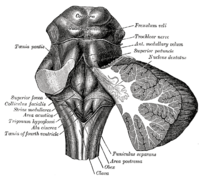
Photo from wikipedia
Accumulation of hyperphosphorylated tau in the locus coeruleus (LC) is a ubiquitous feature of prodromal Alzheimer’s disease (AD), and LC neurons degenerate as AD progresses. Tau-mediated LC dysfunction may contribute… Click to show full abstract
Accumulation of hyperphosphorylated tau in the locus coeruleus (LC) is a ubiquitous feature of prodromal Alzheimer’s disease (AD), and LC neurons degenerate as AD progresses. Tau-mediated LC dysfunction may contribute to early neuropsychiatric symptoms, while loss of LC integrity is associated with conversion to cognitive impairment. Hyperphosphorylated tau alters firing rates in other brain regions, but its effects on LC neurons have not been described. The purpose of this study was to characterize changes in firing properties of LC neurons when they are the only cells containing hyperphosphorylated tau, as well as later in disease when β-amyloid (Aβ) and tau pathology is abundant in the forebrain. Single unit LC activity was recorded from anesthetized wild-type (WT) and TgF344-AD rats, which carry the APP/PS1 transgene. Similar to human AD, these rats develop hyperphosphorylated tau in the LC (at 6 months) prior to Aβ or tau pathology in forebrain regions (at 12-15 months). At baseline, LC neurons from TgF344-AD rats were hypoactive at both ages compared to WT littermates, but showed elevated spontaneous bursting properties, particularly in younger animals. Differences in footshock-evoked LC firing depended on age, with 6-month TgF344-AD rats demonstrating aspects of hyperactivity, and aged transgenic rats showing hypoactivity relative to WT. Tau-induced alterations in LC firing rates may contribute to the pathophysiology of AD, with early hyperactivity associated with prodromal symptoms, followed by hypoactivity contributing to cognitive impairment. These results support further investigation into disease stage-dependent noradrenergic interventions for AD. Highlights Recorded locus coeruleus (LC) neurons in a rat model of Alzheimer’s disease (AD) TgF344-AD rats develop early endogenous LC tau pathology akin to human AD 6- and 15-month TgF344-AD rats had reduced tonic LC firing LC neurons from 6-month TgF344-AD rats were hyperactive in response to footshock LC neuron dysfunction may contribute to AD symptoms
Journal Title: Neurobiology of Aging
Year Published: 2022
Link to full text (if available)
Share on Social Media: Sign Up to like & get
recommendations!